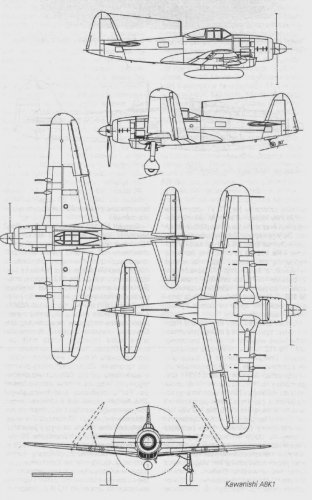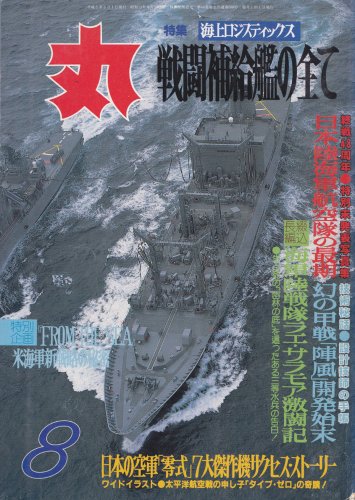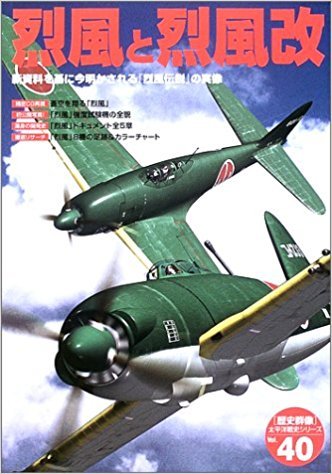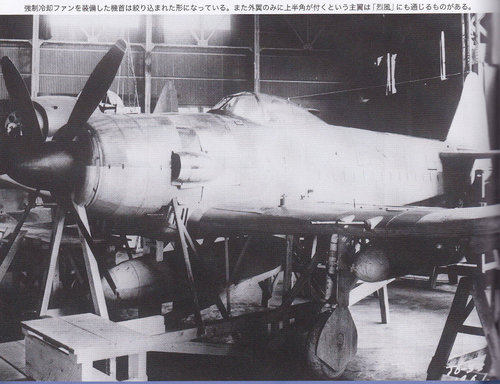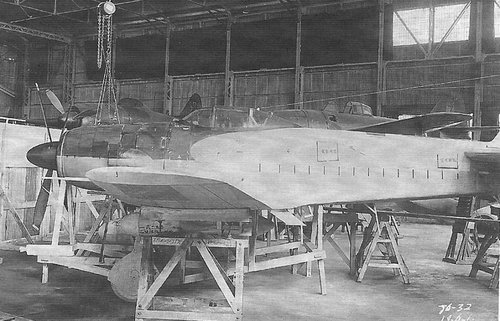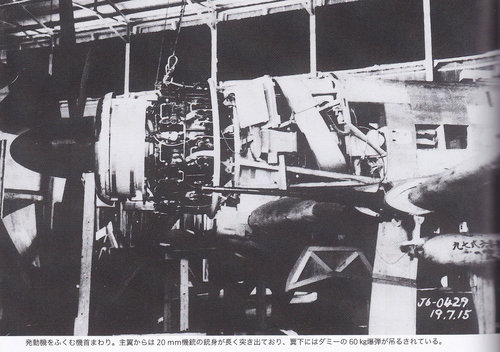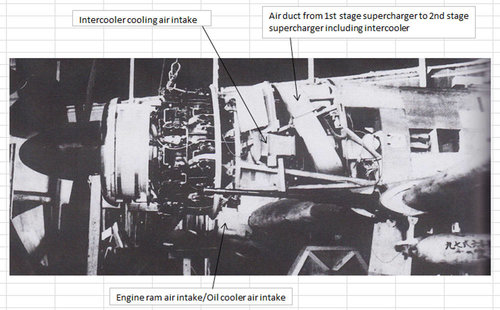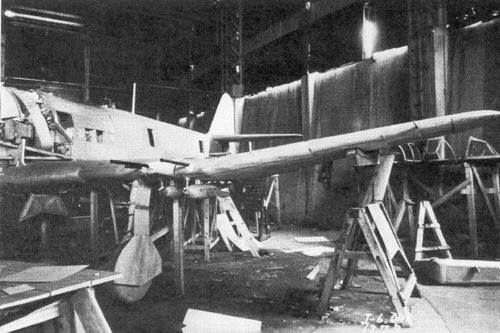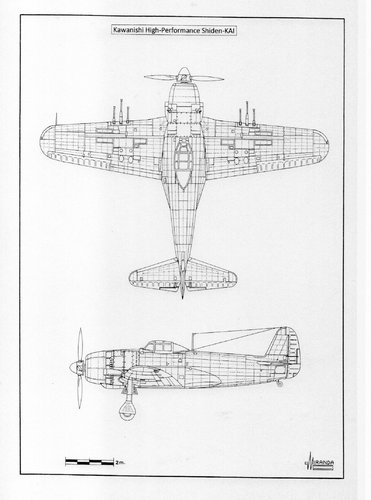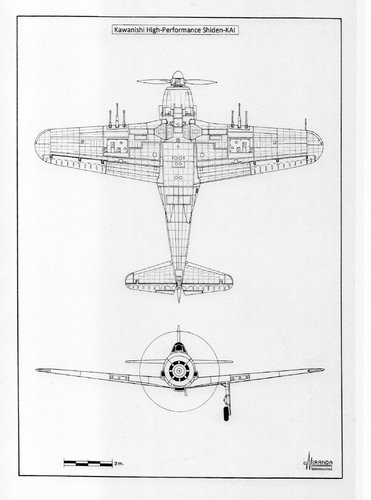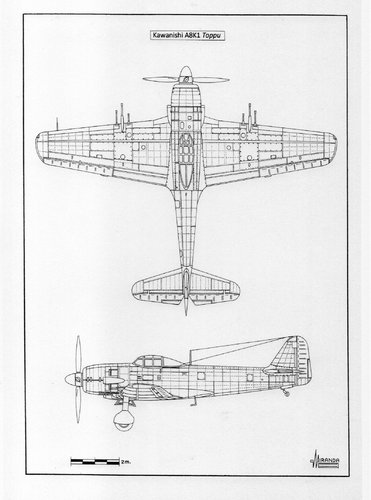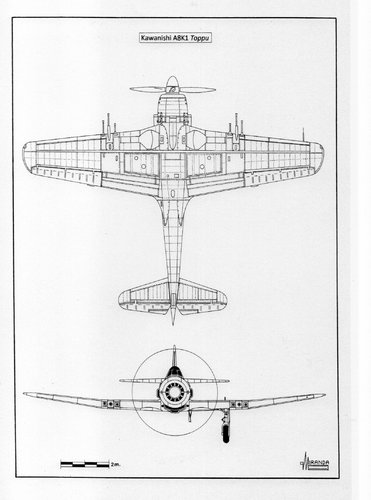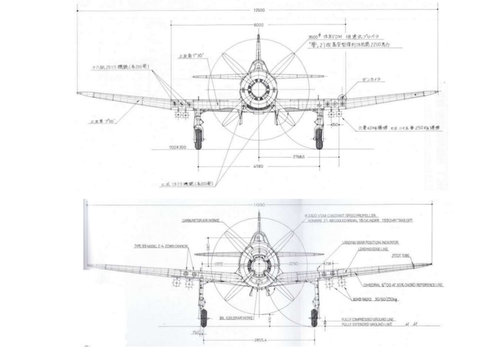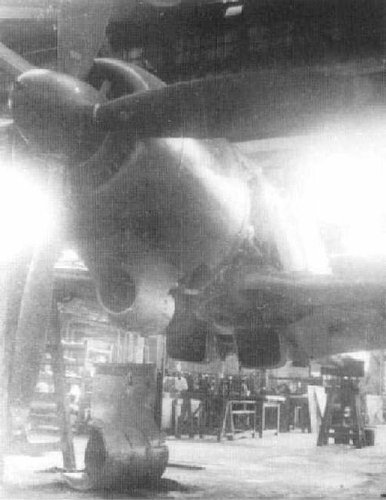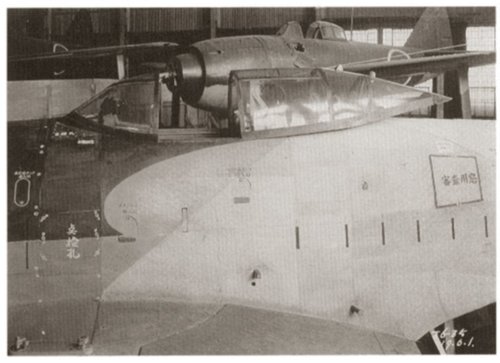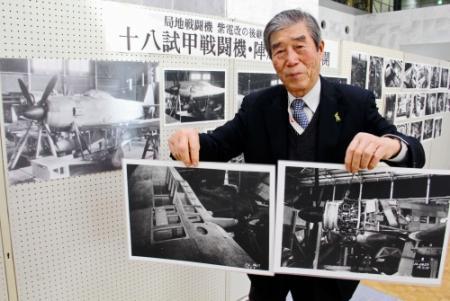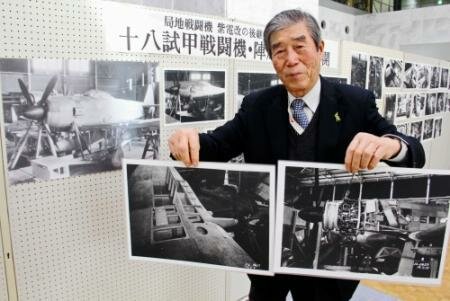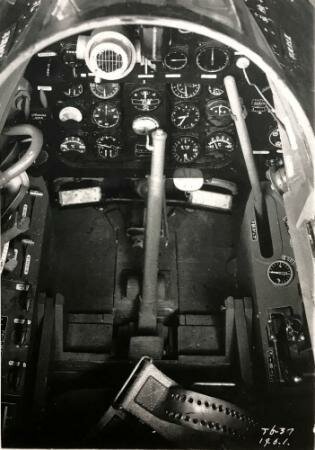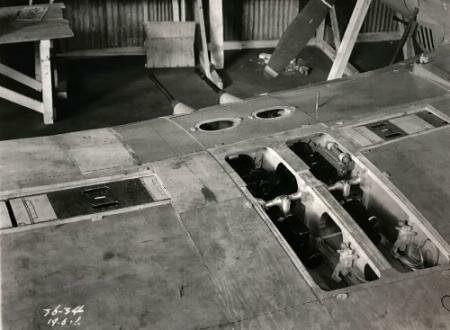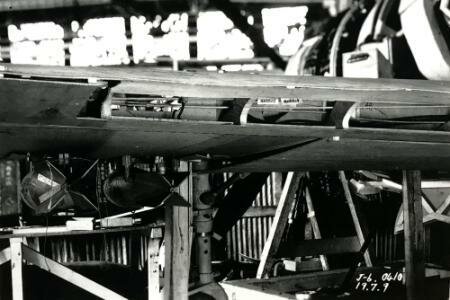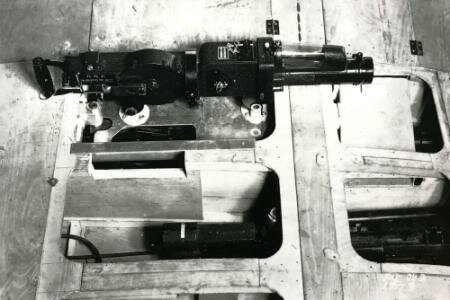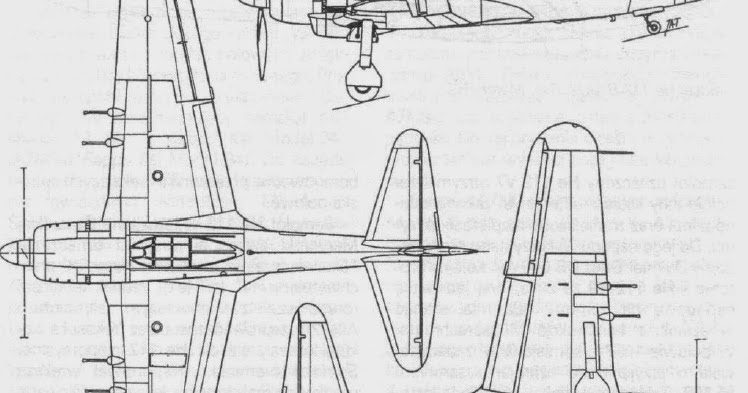Hi! You are very sharp eyed guy. Japanese text says it's unknown instrument. And also says that it might be a FK-3 radar screen. FK-3 was developed by Kawanishi. Weight was 60kg, little heavy.
From "Fighters of the Dying Sun"
When the Japanese industry was able to manufacture radar equipment light enough to be installed on aircraft, the IJN's main interest was in locating enemy ships using ASV (Air-to-Surface Vessel) equipment.
In August 1942 the H-6 Type 3 Mark 6 Model 4 radar entered service, developed by the Oppama Naval Technical Depot and with a range of 100 km against large surface craft. Between 1942 and 1944, a total of 2,000 units of the H-6 ASV were manufactured by Nihon Musen Co. The H-6, also called
Kaze-1, weighted 110 kg and was installed in the four-engine Kawanishi H6K5 and H8K2 flying boats with the mission of locating the U.S. Navy task forces.
The H-6 radar was also used by the Nakajima B6N2 and Mitsubishi G4M2 torpedo-bombers to carry out nightly torpedo attacks and by the Nakajima J1N1 of the 321st Kokutai in anti-submarine patrols and night intruder attacks against torpedo boats, with two 250 kg bombs. The Type 3 Model 1 (KMX) magnetic airborne detector was used for anti-submarine patrols by the Aichi E13A1b and Kyushu Q1W1 specialized airplanes.
The antennae configuration was different for each type of aircraft. The single-engine B6N2 used a Yagi transmitter antenna, with four elements, mounted in the leading edge of the starboard wing, and the four ‘T’ dipoles of the UN-954 receiver mounted in the fuselage sides. In the multi-engine aircraft, the Yagi antenna was mounted in the nose.
The H-6 operated on a frequency of 150 megacycles, with 2 m wavelength and 3 Kw power output. On September 1944 the IJN carried out some tests with the FM-1, a new ASV radar developed by Tokyo Shibaura Denki with the same performances as the H-6 and only 70 kg of weight. The prototype was unsuitable for practical use and production was stopped in favour of the more advanced version called FM-3 that entered service in 1945 with 100 units built. The FM-3 operated with 2 m wavelength and 2 Kw power output, weighed 60 kg only and could be used by medium size anti-submarine plans, but its range was reduced to 70 km.
The N6 was another ASV designed to equip small patrol planes and operated with 1.2 m wavelength and 2 Kw power output and weighted 60 kg. Only flying tests were conducted with prototypes. Nihon Musen Co. built 20 units in 1944, but It never entered service. Other ASV projects that were not built were the FK-3, a version of the FM-3 developed by Kawasaki for the J6K1
Jinpu, with PPI display and 60 Kg, and the FK-4, a more powerful version for large patrol planes, with 20 Kw power output and 100 km range.
All these radars used the same type of antennae than the H-6 and had limited capabilities to detect airplanes, but the fuselage receiver dipoles could not search the area ahead of the airplane. The approach to the target had to be oblique to maintain radar contact and its use in nigh fighters was impractical.
The
Kasumi-51 was a prototype of cartographic pathfinder radar based on the H2S of a British bomber downed in Rotterdam. In 1944 the Germans sent the Japanese a complete schematic of this equipment which operated at 10 cm wavelength with 5 Kw power output, with parabolic rotating antenna and PPI display. Only three prototypes of the
Kasumi-51 were built in 1945. During the flying tests it was confirmed that the distance at which it would pick up the shore was only 20 Km, which discouraged large scale production.
As the war progressed AI (Airborne Intercept) radars was developed from the H-6 to locate the enemy night intruders. Some Nakajima J1N1-S and Kawanishi P1Y2-S
Kyokko night fighters were experimentally equipped with H-5/FD-1 radars that didn't work well during operational flying tests. The IJN decided to develop specialized AI radars for night fighters.
In August 1944 the FD-2, developed by the 2nd Naval Technical Institute, entered service with the
Gekkos of the 302nd Kokutai. The new AI radar used four nose-mounted Yagi antennae, with five element each, one pair for sending and one pair for receiving. The FD-2 operated with 25 cm wavelength, 2.5 Kw power output and 3 to 10 Km range, weighted 70 kg and a total of 100 units were built.
The FD-2 was used in combat without good results due to the effective countermeasures used by the B-29s. As with the
Hirschgeweih antennae used by the
Luftwaffe, the Japanese discovered that Yagi antennae generated too much drag, penalizing the performances of the
Gekko.
Between September 1944 and April 1945, the firm Tokyo Shibaura Denki tried to develop, without success, a new type of antenna embedded in the wing leading edge to save drag. In August 1944, ten prototypes of the
Gyoku-3 AI radar were built, using the direction-finding technique to produce a forward conical scan, with the radiating antenna enclosed in a nose wooden radome and one ‘T’ dipole receiver mounted the under nose. The Gyoku-3 operated in a frequency of 150 megacycles with 3 Kw power output and 4.5 Km range. It was expected to be used in the new Aichi S1A
Denko night fighter but did not get into service. Day time flight tests were performed at Yokosuka Naval base in May 1945.
By the end of 1942, the Tama Technology Research Institute, in cooperation with Toshiba Shibaura Denki and Nippon Electric Co, developed for the IJN an airborne ASV radar denominated
Taki-1, ‘Ta’ was for
Tama and ‘Ki’ for
Kuki (Air). The
Taki-1 Model 1 operated at 150 cm wavelength with 10 Kw power output and 100 Km range. During flying tests, performed late in 1943, it used two Yagi antennae, with three elements each, mounted on the nose and starboard wing of one Nakajima Ki.49 bomber.
The Model 1 gave satisfactory search performance, but with 150 Kg it was heavy for airborne equipment. The Model 2 was designed in 1944, with only 80 Kg, for the Mitsubishi Ki.67-I
Yasukuni torpedo-bomber.
One Yagi antenna, with five elements, was mounted in the starboard wing and two ‘X’ array was mounted on either side of the rear fuselage. Each of these antennae could transmit and receive by means of an automatic switch and all three antennas could be used in rapid rotation, or singly to determine relative direction. One A-Type presentation rangefinder provided accurate ranging. Nihon Musen Co. built 1,000 units of the Model 2 in 1944. A lighter Model 3 had been developed for fighter bombers, but it was still in the laboratory when the war ended.
The
Taki-2 was an AI radar based in the German FuG 202
Lichtenstein B/C. It was an 80 cm wavelength ‘radio locator’, with 2 Kw power output and 3 Km range, developed in 1944 for the IJA Kawasaki Ki.45-KAI-
Bo night fighter. It used four Yagi antennae with five elements and folded driving dipoles, mounted in the nose plane, with the antennas installed in a transparent radome. Each of these antennae could transmit and receive. A motor driven distributor connected each antenna to the receiver in rapid succession, for azimuth, elevation and range determination. It is believed that at least 12
Toryus were converted to ‘
Bo’ configuration and were undergoing operational tests at the time the war ended. It does not seem likely that this set would have given enough directional accuracy for night fighting operations. Early in 1945 studies were being made resulting in the Model III (
Tama-3) AI radar, with 20 cm wavelength and 70 Kg weight.
Taki-3 was an airborne ASV sea search radar, developed in August 1943 by the radio department of the Aeronautical Laboratory from Tokyo Imperial University. The Tama Institute rejected the set in 1944 due to its poor performance.
Taki-8 was a ‘wave disturber’ jammer designed by the X-band of the B-29.
Taki-11 was a high-altitude radio-altimeter (based in the German Siemens FuG 101, with two inverted ‘T’ dipoles mounted under the wings) with 80 cm wavelength and 12,000 to 200 m range. It was developed for the Nakajima Ki.201 jet fighter.
Taki-13 was the low-altitude version for the Ki.67 torpedo-bomber, with 150 to 20 m range. A total of 1,000 units were manufactured.
Taki-14 was a prototype of cartographic pathfinder radar, based on the British H2S, with parabolic rotating antenna and PPI display. It operated at 27 cm wavelength, with 2 Kw power output and 2 Km range, with just one prototype being built by Tokyo Shibaura Denki Co. in 1945.
Taki-15 Type I was an airborne IFF transponder, with 150 Km range, for the emissions of the
Tachi-3 ground radar. It was developed for the Ki.201 jet fighter with one rod antenna mounted in the back of the rear fuselage.
Flight tests showed heavy interferences caused by corona effect at high-altitude, a defect that was amended in the Type II refined version using a T-R tube to protect the receiver and one rod antenna mounted under the fuselage belly. Hundred and twenty units were built in 1945.
Taki-23 was a jammer covering the wave lengths from 7 meters to 80 centimetres.
Taki-24 was a version of the
Taki-14 with 10 cm wavelength.
Taki-30 was an IFF device with rod antenna, carried by the Ki.201 interceptor to indicate to the ground system
Tachi-28 its accurate location. Fifty units were built in 1945.
Taki-34 was a version of the
Taki-24 developed by Sumitomo Co. in November 1944, with 5 cm wavelength, 10 Kw power output and 80 cm parabolic antenna.
As a result of the raid carried out by Doolittle bombers in April 1942, the IJA began the construction of a chain of 14 radar sites covering the south and east of the main Japanese islands, from Ashizurimisaki to Shimoshizu, including the island of Hachijo-jima. This radar warning system, equivalent to the British Chain Home, used
Tachi-6 radar sets (‘Ta’ was for Tama and ‘Chi’ for ground) with 300 km range. When the Saipan-based B-29 heavy bombers made their first raid against Tokyo, in November 1944, they were detected by the
Tachi-6 thirty minutes in advance, approximately the time it took for
Shoki, Toryu and
Raiden interceptors to climb to 9,000 m, the flight altitude of the B-29s.
The problem for the Japanese fighters was that American bombers were flying at more than 700 kph, driven by a strong wind of 220-290 kph. These winter winds, common in the area, had not been foreseen by the Americans and greatly affected the accuracy of the bombardment, who had to use the AN/APQ-7 cartographic radar to locate targets frequently hidden by clouds. Early in March 1945 the AAF staff decided to change the bombing tactic to a series of low-altitude night attacks with M-47 and M-69 incendiary bombs.
Until then the Japanese reaction had not been very effective. Out of the seventy-eight B-29s lost in combat missions between November 1944 and March 1945, fifty-three were for mechanic failures, mainly in engines. The Japanese fighters lacked heavy weapons capable of severely damaging the giants and were forced to fight them through air-to-air bombing and suicide attacks. When the bombers began to be escorted by P-51 day fighters on April, the chances of the twin engine Ki.45, Ki.46 and J1N1 decreased and were withdrawn from service.
Though the majority of 64 sites of Japanese radars provided early warning, some gun-laying Sumitomo
Tachi-3 sets directed AA guns and searchlights, but rarely managed to coordinate their performance due to the effective jamming systems Windows and Rope used by the B-29s. The design of these countermeasures was based on intelligence reports that revealed that the
Tachi-3 operated at 200 megacycles because it was based on a British GL Mk.II captured in Singapore.
As a result of these tactics, out of more than thirty-one-thousand-and-three hundred
B-29 sorties over Japan, only seventy-four were downed by interceptors (42 of them by ramming) and 20 by the AA guns. Early in 1942 the IJN used two types of ground-based radars. The early warning Mark I Model 1 (3 m, 100 MHz) and the gun-laying Mark IV Model 1 (1.5 m, 200 MHz). A Mark I captured by the U.S. Marines at Guadalcanal in August 1942 allowed the Americans to know firsthand the level achieved by Japanese technology and to design the first countermeasures systems.
In March 1943 a B-24
Ferret, fitted with an APA-24 Direction Finding antenna, performed reconnaissance flights over Kiska Island and discovered signatures of two Mark I radars. Some Consolidated PBY flying boats were also configured as
Ferrets, but neither them nor the submarines equipped with SIGINT devices could detect the new typed of Japanese radars in 1943. In February 1944, following the capture of Kwajalein Atoll, the Americans found information about the Mark II Model 2 shipboard radar (10 centimetres, 3 GHz).
Some B-29s were fitted with SIGINT and jammer countermeasures to pick-up Japanese surface radars and other B-29 specialised in jamming missions, known as
Porcupines, accompanied the bomber formations. The Japanese also tried to develop
jammers and IFF devices that never got into combat as their performances were considered inferior to those of the American teams that could interfere with them.
Japanese GCI fighter direction was rudimentary and over Japan there was often chaotic radio-communication, with night fighters left to their own devices. The IJA and the IJN used separate warning systems. In June 1944 the Imperial General Headquarters instructed the integration of the Atsugi, Iwakuni and Omura IJN Kokutais into the respective IJA district. As late as March 1945 the IJA/IJN cooperation had been made effective only in Kobe, Nagoya and Kyushu with less than one-fifth of its fighters assigned to home defence.

